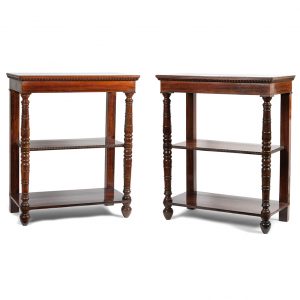Louis XVI period, circa 1777-1780.
H. 91 x L. 51.5 x D. 48.5 cm.
These chairs, classics of the Louis XVI repertoire, are in lacquered wood with a slightly curved hat back, basket handle, rudent fluted feet, curved belt; the backrest and the belt decorated with twist of ribbon.
Jacob is recognized as the most talented and famous carpenter of the late 18th century. He gives us all his talent here with a particularly successful design of the seat, the slightly curved backrest and the curved seat, thus avoiding the too dry stiffness of a standard Louis XVI chair. Note that this curve of the side belt, joining the rear connection dice, requires a larger section of wood. The fleurette inscribed in the dice is still carved in the mass, unlike later works and series, where a prefabricated daisy is applied.
Among his prestigious clientele, figure, and not least, the Count of Artois who entrusted him with numerous orders to refurnish his various châteaux. It was in 1777 that the Comte d'Artois became the owner of several residences, such as Saint-Germain or Bagatelle, and which he therefore had to furnish up to date. We can date this pair of chairs from the years 1777-1780.
Each of them has the front sash marked in fire with the initials in English letters AT, for Artois and GM in block letters, for storage, as well as SG under an open crown with three fleur-de-lis for Saint-Germain; they are stamped by G. Jacob. If he has addressed the latter here, we know that Nadal the elder and Boulard were also among his main suppliers.
These chairs are a rare testimony to the collections of the Count of Artois, a fortiori for the Château-Neuf de Saint-Germain.
- Charles-Philippe de France, comte d’Artois (1757-1836), at Château-neuf de Saint-Germain-en-Laye.
- French particular collection
Other chairs with the same brands for the Comte d'Artois in Saint Germain, from a series of 4 in gilded wood with medallion backs by Nadal the elder, are in the national furniture collections.
Château Neuf de Saint Germain, now largely destroyed, was a 17th century royal residence from 1659 to 1680, when the court returned to the nearby Vieux Château. Commissioned by Henri II and Catherine de Médicis, and built by Philibert Delorme, this castle was further enlarged by Henri IV and saw the birth of Louis XIV.
It is an elongated building on the ground floor, made up of 4 pavilions, built on a large esplanade, on a sloping ground which offers a vast and magnificent panorama towards the Seine.
Louis XVI gave in 1777 the Château Neuf, in dilapidated state, to his younger brother the Count of Artois who planned demolition and reconstruction through his architects Boullée and Bélanger. The revolution of 1789 put an end to all his plans to declare the castle a national property, due to the emigration of the Comte d'Artois.
It is then largely demolished, and the park subdivided. Only a few vestiges remain today, such as the Henri IV and Sully pavilions, and a terrace and its two ramps.
From 1777, the multiplicity of estates and castles of the Comte d'Artois, necessitated the management of the movable collections by the creation of the storage of the Comte d'Artois; in fact, the Prince has the Temple in Paris, inherited from the Prince de Conti, the Château Neuf de Saint Germain, the castles of Maisons and Bagatelle, for the most important.
The furniture did not come under the Crown's storage, but the private storage of the Comte d'Artois, under the direction of Pierre-Thomas Jubault (1742-1837), from a family of locksmiths from the King at Versailles. We find him in 1775, custodian and concierge of the Count of Artois, he resides at the Palais du Temple in Paris, of which the Count of Artois had the usufruct during the minority of his son the Duke of Angoulême. He is in charge of the management and purchase of the furniture and he is the principal of the orders. This administration, however, does not reach the precision of that of the Crown, we do not know to date of general or particular inventories of furniture.
It is Jubault who will put in place the affixing of the marks to distinguish the places of origin of each piece of furniture, and it is Laurent-Augustin Gariby, also in official accommodation at the Temple (since he was the locksmith of the Prince of Conti) who is the author of the irons to mark the furniture of the Artois collections: "Two steel marks ... with a wooden handle to hold them when they are red" (Archives d'apanage d'Artois at the National Archives, series R1 319).
Each residence had the corresponding letters, thus B under an open crown for Bagatelle, M for Houses, T for Temple, E P for the stables of Paris, and E W for those of Versailles, and finally S G for Saint-Germain. The furniture is thus branded with the English letters AT for Artois or CDA for Charles d'Artois, under closed crown.
Literature
- Antique dealers in Paris, under the dir. of Didier Aaron, La folie d'Artois, 1988, p. 96 and 114.
- Delphine LAMAZOU, The furniture of the Comte d'Artois between 1757 and 1789, in: Bagatelle in its gardens, artistic action of the city of Paris - Friends of Bagatelle, 1997.












